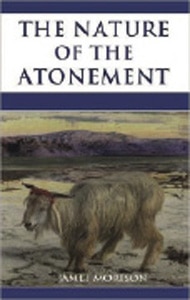
Paperback, 99 pages, Published by Scripture Teaching Library, Cookstown, Northern Ireland. ISBN 978-1-909789-19-7.
James Morison (1816-1893) was a Scottish minister of the Gospel who was greatly used by God to bring many souls to Christ. Both this small treatise and his companion work The Extent of the Atonement went through many editions during the author’s lifetime, and is here reprinted in a new edition by the Scripture Teaching Library.
The paperback is well-designed with an attractive cover depicting Holman Hunt’s painting ‘The Scapegoat’, which is based on the ritual of the Levitical Day of Atonement. Strictly speaking, the doctrine of the atonement is really an Old Testament concept. The one reference to ‘the atonement’ in the New Testament of the KJV, namely, Romans chapter 5 verse 11, should be translated ‘the reconciliation’. The Old Testament concept of atonement probably has more of the idea of covering sin than finally removing it. However, Bible scholars often use the word to refer to the final removal of sin as an offence to God by means of Christ’s vicarious sacrifice on the cross. In other words, ‘atonement’ is often used to describe Christ’s work of ‘propitiation’, which is found several times in the New Testament.
James Morison first distinguishes what he calls ‘the atonement’ from other related doctrines, such as, pardon, justification, redemption, reconciliation, and payment of debt, before he defines what he means by the word in chapter 7. He does so as follows: ‘It is an expedient introduced into the Divine moral government, consisting of the obedience unto death of Jesus Christ, which has completely removed all legal obstacles standing between man and the attainability of salvation’. This is really what the word ‘propitiation’ means. He points out that the only remaining obstacle to man’s reception of salvation is his culpable unbelief. The other aspects of our salvation mentioned above flow from this basic truth of propitiation.
James Morison’s argument is logical, close-knit, and characterized by a certain Victorian style of writing. This may make it difficult for some interested readers to follow easily, but the little book is a seminal explanation of a vital truth of our faith, and should be studied carefully. It is recommended for serious Bible study.
Our thanks to Malcolm Davis, Leeds, England, for this review.
| Cookie | Duration | Description |
|---|---|---|
| cookielawinfo-checkbox-advertisement | 1 year | Set by the GDPR Cookie Consent plugin, this cookie is used to record the user consent for the cookies in the "Advertisement" category . |
| cookielawinfo-checkbox-analytics | 11 months | This cookie is set by GDPR Cookie Consent plugin. The cookie is used to store the user consent for the cookies in the category "Analytics". |
| cookielawinfo-checkbox-functional | 11 months | The cookie is set by GDPR cookie consent to record the user consent for the cookies in the category "Functional". |
| cookielawinfo-checkbox-necessary | 11 months | This cookie is set by GDPR Cookie Consent plugin. The cookies is used to store the user consent for the cookies in the category "Necessary". |
| cookielawinfo-checkbox-others | 11 months | This cookie is set by GDPR Cookie Consent plugin. The cookie is used to store the user consent for the cookies in the category "Other. |
| cookielawinfo-checkbox-performance | 11 months | This cookie is set by GDPR Cookie Consent plugin. The cookie is used to store the user consent for the cookies in the category "Performance". |
| elementor | never | This cookie is used by the website's WordPress theme. It allows the website owner to implement or change the website's content in real-time. |
| viewed_cookie_policy | 11 months | The cookie is set by the GDPR Cookie Consent plugin and is used to store whether or not user has consented to the use of cookies. It does not store any personal data. |